
Carex scoparia is a species of sedge known by the common names broom sedge and pointed broom sedge. It should not be confused with the unrelated grass species known as "broom sedge," Andropogon virginicus.
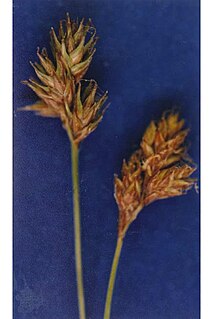
Carex straminiformis is a species of sedge known by the common name Shasta sedge.

Deschampsia danthonioides is a species of grass known by the common name annual hairgrass. It is native to western North America from the Yukon Territory and British Columbia, through California and the Western United States, to Baja California, and also to southern South America in Chile and Argentina.
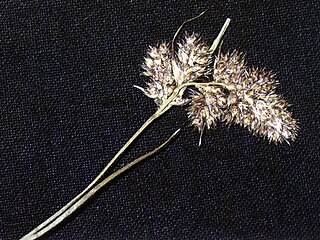
Luzula spicata is a species of flowering plant in the rush family known by the common name spiked woodrush. It has a circumpolar distribution, occurring throughout the northern Northern Hemisphere in Europe, Asia, and North America. It grows in subalpine and alpine climates. It occurs at low elevations in colder regions, such as tundra; farther south it is restricted mainly to high mountains. It is a perennial herb forming grasslike clumps of several erect, reddish stems up to about 33 centimeters in maximum height. The stem is thick and its base is buried several centimeters in the soil where it attaches to the roots. The inflorescence is an array of several clusters of brown bristle-tipped flowers. The surrounding bracts and the sheaths surrounding the leaf bases are lined with hairs.

Lycopodiella inundata is a species of club moss known by the common names inundated club moss, marsh clubmoss and northern bog club moss. It has a circumpolar and circumboreal distribution, occurring throughout the northern Northern Hemisphere from the Arctic to montane temperate regions in Eurasia and North America. It grows in wet habitat, such as bogs, ponds, moist spots on the tundra, and long-standing borrow pits.

Muhlenbergia filiformis, known by the common name pullup muhly, is a species of grass. It is native to western North America from western Canada through the Western United States to northern Mexico.

Poa bolanderi is a species of grass known by the common name Bolander's bluegrass. It is native to western North America from British Columbia to Utah to California, where it is a resident of mountain habitat, particularly pine and fir forests. It is an annual grass growing in clumps up to 60 centimeters tall. The inflorescence occupies the top 10 to 15 centimeters of the stem. It is narrow in flower, with branches appressed, growing parallel to the stem. As the fruit develops the branches spread out, becoming perpendicular to the stem, nodding, or drooping. The branches have few, sparse spikelets.

Poa glauca is a species of grass known by the common names glaucous bluegrass, glaucous meadow-grass and white bluegrass. It has a circumboreal distribution, occurring throughout the northern regions of the Northern Hemisphere. It is also known from Patagonia. It is a common grass, occurring in Arctic and alpine climates and other areas. It can be found throughout the Canadian Arctic Archipelago in many types of habitat, including disturbed and barren areas.

Solidago multiradiata is a species of goldenrod known by the common names Rocky Mountain goldenrod, northern goldenrod, and alpine goldenrod. It is native to North America, where it can be found throughout the northern regions, including Alaska and most of Canada (all 3 territories plus all provinces except Prince Edward Island, including territory north of the Arctic Circle. Its distribution extends through the western United States as far south as Arizona, New Mexico, and California. It is known mostly from the subalpine and alpine climates of high mountain ranges. Its habitat includes tundra and mountain meadows.

Stellaria longifolia is a species of flowering plant in the family Caryophyllaceae known by the common name longleaf starwort. It is native to much of the northern half of the Northern Hemisphere, occurring throughout northern Europe and North America. It grows in many types of moist habitat, including meadows, marshes, and roadsides. It is a rhizomatous perennial herb forming clumps with sprawling, branching stems which are mostly hairless except for tiny rough hairs along the edges of the squarish stem. The linear to lance-shaped leaves are up to 3.5 centimeters long and are oppositely arranged in pairs. The inflorescence bears several flowers, each on a short pedicel. The flower has five pointed green sepals each a few millimeters long. There are five white petals, each so deeply lobed it appears to be two.
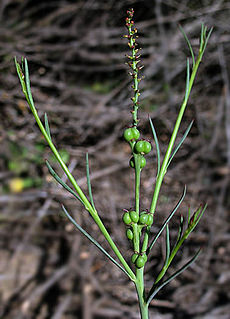
Stillingia linearifolia is a species of flowering plant in the euphorb family known as queen's-root.
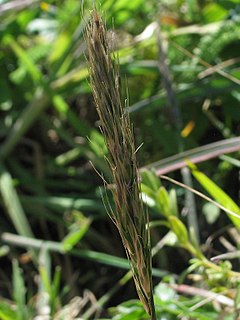
Trisetum canescens is a species of grass known by the common names tall trisetum and tall false oat.

Trisetum wolfii is a species of grass known by the common names Wolf's trisetum and Wolf's false oat. It is native to western North America, including southwestern Canada and the western United States. It occurs in mountain habitat at moderate to high elevations below the tree line, such as spruce, fir, and aspen stands. It is a perennial grass forming clumps of erect stems growing up to about 80 centimeters in maximum height, occasionally reaching one meter. The narrow leaves are mostly located on the lower third of the clumped stems. The inflorescence is a narrow, erect panicle with spikelets green, brownish, or purple in color.
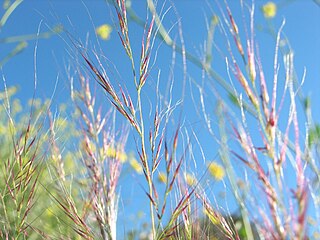
Vulpia microstachys is a species of grass known by the common names small fescue and small sixweeks grass. It is native to western North America from British Columbia to Colorado and New Mexico to Baja California, where it grows in many types of open habitat, including grasslands. It is dominant on some grasslands of California, and it was probably an abundant native grass before the habitat was altered by invasive non-native grasses. It occurs on serpentine soils with associates such as serpentine reedgrass. It is also known from parts of South America. It is an annual grass producing one stem or a clump of several stems growing up to 75 centimeters tall. The inflorescence has several open branches bearing clusters of purple-tinged spikelets. The spikelet has one to six flowers. The grass is usually cleistogamous, its flowers fertilizing themselves.

Achnatherum nelsonii is a species of grass known by the common names Columbia needlegrass, subalpine needlegrass, and western needlegrass. It is native to western North America, from Yukon and British Columbia to California to Texas.

Calamagrostis montanensis is a species of grass known by the common names plains reedgrass and prairie reedgrass. It is native to North America, where it is found across Canada from British Columbia to Manitoba and south to Colorado in the United States.

Poa arida is a species of grass known by the common names plains bluegrass and prairie speargrass. It is native to North America, where it occurs throughout western and central Canada and the central United States. It is most common east of the Continental Divide; specimens west are often misidentifications.

Poa fendleriana is a species of grass known by the common name muttongrass. It is native to western North America, where its distribution extends from western Canada to northern Mexico.
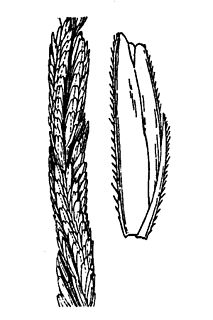
Spartina spartinae is a species of grass known by the common names gulf cordgrass and sacahuista. It is native to the Americas, where it occurs from the Gulf Coast of the United States south to Argentina.

Leymus mollis is a species of grass known by the common names American dune grass, American dune wild-rye, sea lyme-grass, strand-wheat, and strand grass. Its Japanese name is hamaninniku. It is native to Asia, where it occurs in Japan, China, Korea, and Russia, and northern parts of North America, where it occurs across Canada and the northern United States, as well as Greenland. It can also be found in Iceland.




















